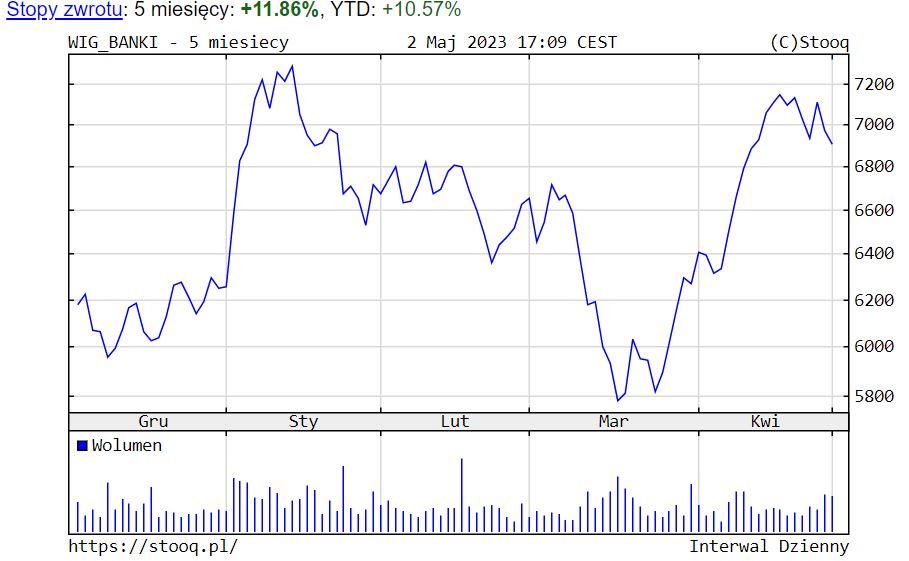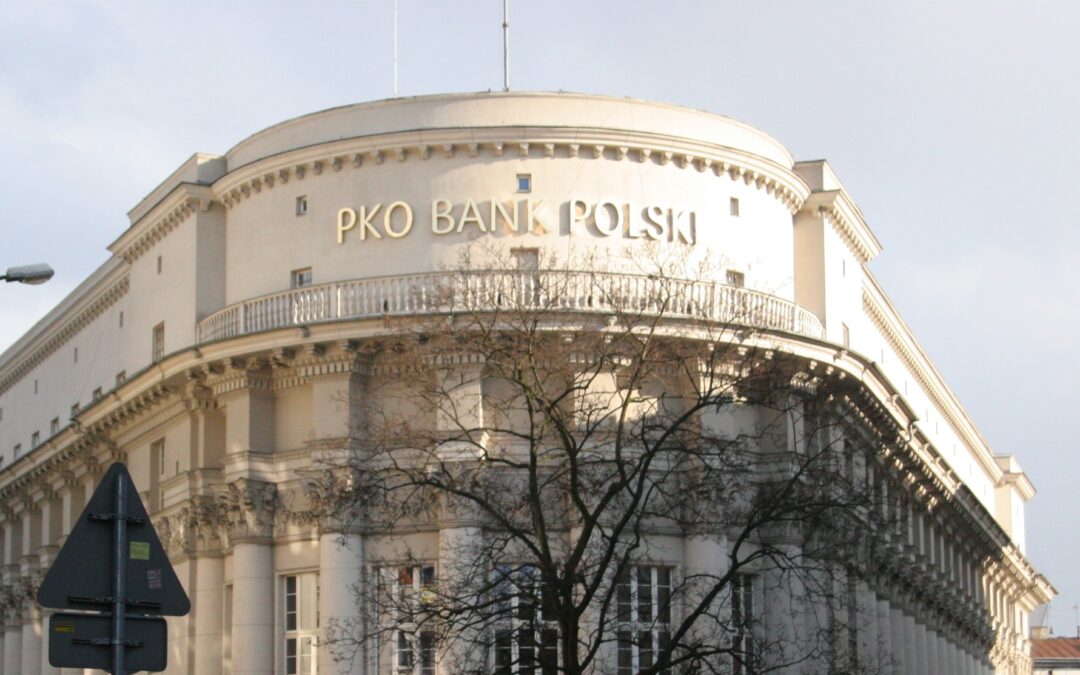By Anna Rzhevkina
The sudden collapse of Silicon Valley Bank and Credit Suisse’s takeover by its rival UBS shook global financial markets, amid fears of potential spillover. Poland’s banking sector looks unlikely to suffer such effects, but it is facing local issues of its own that will test its resilience.
The Silicon Valley Bank (SVB) case marked the largest US banking failure since the 2008 financial crisis. SVB relied heavily on deposits of tech startups, which the bank invested into long-term government bonds. As startups began withdrawing their deposits to stay afloat amid tougher private funding conditions and a chilly IPO environment, SVB found itself short on capital.
In response, the bank announced a plan to raise more than $2 billion in capital, but did not succeed. The sudden need for capital prompted more clients to withdraw their deposits, and within just two days, the bank collapsed.
PI PODCAST: @PiotrSobolewski zastanawia się, czy znaleźliśmy się na skraju kryzysu bankowego, opowiada o reakcjach regulatorów, rynków i polityków. Przygląda się polskiemu sektorowi finansowemu i wskazuje jego słabe punkty. Prowadzi @hanna_cichy.
▶️ https://t.co/xE4NG8RPdb pic.twitter.com/QKjQGH0PTJ
— Podcasty Polityki Insight 🎙️ (@PI_Podcasts) March 17, 2023
Polish banks resistant to turmoil
Shortly after, Credit Suisse said it had found “material weaknesses” in its internal controls over financial reporting, and at the end of March Swiss rival UBS agreed to a $3.25 billion deal to buy Credit Suisse. Today, after three US banks failed in the past two months – including a takeover of the majority of assets of the First Republic bank by Wall Street giant JP Morgan this week – investors globally fear a new financial crisis.
Although the banks’ sub-index on the Warsaw Stock Exchange initially tumbled following global stocks, it has now recovered all losses and is at its highest level since January this year, while the US and European bank indexes are still treading water. Polish government spokesman Piotr Müller said at the end of March that the government sees no threat to Poland’s banking system, but is monitoring the situation.
The sector is characterised by high stability and is one of the best developed in Central and Eastern Europe, according to the market research platform EMIS. At the end of 2021, the banking sector’s assets were worth 98.1% of GDP, considerably above the 91.6% average over the previous five years.

Quotations of the banking sub-index on the Warsaw Stock Exchange from December 2022 to April 2024. Source: stooq.pl
In Poland, banks are relatively concentrated, with the five largest lenders – PKO BP, Bank Pekao, Santander Bank Polska, ING Bank Śląski and mBank – holding a combined 56.6% share in total assets, according to EMIS data from 2021.
Foreign capital accounts for more than half of the sector’s assets, while state capital makes up slightly less than a third, with the remainder coming from Polish private capital.
The SVB case might remind Poles of the forced restructuring of the country’s tenth biggest lender, Getin Noble Bank (GNB), by the Polish Bank Guarantee Fund (BFG) in September 2022. While the failure of SVB was sudden, the Polish bank had been in trouble for years, and even after its collapse, customers continued to have access to their savings. Moreover, the restructuring was virtually painless for the sector.
“If the termination of operations by such a large financial institution does not have any major effects on the sector and its clients, it means that it is built on solid foundations,” EMIS economist Andrzej Żurawski said in a statement.
For more on last year's forced takeover of Czarnecki's Getin Noble Bank, see our report from the time https://t.co/jr1qmcOF9U
— Notes from Poland 🇵🇱 (@notesfrompoland) April 12, 2023
Poland’s biggest lender, PKO BP, says the risk of a case similar to SVB is extremely low in Poland. According to a report compiled by one of its economists, Anna Wojtyniak, Poland has a fundamentally different deposit base compared to SVB, which is diversified and focused on retail.
Still, serious market distortions may put stress on any banking system, the report notes. In the last three years, Poland experienced two “run on the bank” periods. The second wave of deposit withdrawals occurred two years later in response to the outbreak of the war in Ukraine.
Kamil Pastor, an economist at PKO BP, told Notes from Poland that the Polish financial sector is much smaller and operates on a “more basic banking business” than the US. But Poland can learn from the SVB case that it is important to have efficient supervision of the financial sector and to avoid imbalances that would be difficult and costly to fix.
Long-standing problems
Despite strong sector fundamentals, Polish banks have to deal with a number of risk factors. One of the major issues is surging inflation, which in March was at 16.1% year on year, down from an over 26-year high just a month before and with the central bank’s attempts to contain it with monetary policy tightening. On the one hand, when interest rates rise, banks generally earn more due to higher margins. Indeed, in January-February, the net profit of the Polish banking sector jumped by 49% year-on-year to 6.1 billion zloty (€1.33 billion), according to the National Bank of Poland.
However, high inflation has a negative effect on consumers’ actual disposable income. As a result, companies are more careful with investments, and high rates may discourage firms and households from taking loans. In addition, the government last year launched so-called credit holidays, allowing borrowers to postpone payments of instalments for several months to soften the effects of rising rates.
For more read our previous reporthttps://t.co/TzKcswKvS7
— Notes from Poland 🇵🇱 (@notesfrompoland) December 29, 2022
Marcin Jabłczyński, head of Investor Relations & ESG Department at Bank Pekao, told Notes from Poland that the programme had a negative impact on the financial results of Polish banks in 2022 and cost the sector over a dozen billion zloty. Jabłczyński added that currently, the key risk factor for the Polish banking sector is the issue of mortgage loans in Swiss francs.
Thousands of Poles took such loans more than a decade ago, attracted by lower interest rates. However, after the Swiss franc soared against the zloty in 2015, borrowers had to pay much bigger instalments. Many took banks to court to dispute loan terms. In February this year, the European Court of Justice’s (ECJ) advice issued an opinion in favour of borrowers in ongoing disputes with local lenders.
After the adviser’s opinion rating agency Fitch estimated that Polish banks could face higher losses and are likely to speed up their provisioning efforts. Jabłczyński from Pekao confirmed that banks have already set up “considerable provisions”; however, the situation “is developing in a negative direction for the sector, which will generate further costs for the banks”.
Although the adviser’s opinion is non-binding, the ECJ generally tends to follow their recommendations. Still, Fitch does not expect an immediate impact on the sector.
“It will still take time for Polish courts to assess whether customers have a right to claim for additional compensation under Polish law, and to establish an approach to dealing with claims,” the agency said.
Indirect impact
While the collapse of SVB may not have a direct impact on the Polish financial sector, it could lead to a significant reduction in available funding for emerging market startups, which is already on the decline as investors become risk-averse.
“VC activity in emerging markets is largely dependent on global economic conditions and investor confidence,” EMIS wrote in a statement.
However, Jabłczyński from Pekao remains optimistic and believes that the banking crisis in the US only caused a short-term deterioration of investor sentiment.
He stressed that the SVB case shows that the deposit base should be dispersed to avoid “the knock-on effect” of deposit withdrawals, and the importance of managing interest rate risk.
At the same time, the Polish central bank forecasts that banks may not return to pre-pandemic profitability, and the legal risks associated with mortgages in Swiss francs may become a heavy burden for the sector.
The ongoing war in Ukraine also affects the economy of the entire Central and Eastern Europe region. Despite these obstacles, the Polish banking sector appears to be stable enough to deal with uncertainties.
Poland recorded the EU's biggest fall in GDP from the third to fourth quarter of 2022, new @EU_Eurostat data show.
Its economy shrank by 2.4% whereas the majority of member states saw a rise in GDP.
For more, see our report: https://t.co/r8T78GYtkq pic.twitter.com/Pn5k9sWn4l
— Notes from Poland 🇵🇱 (@notesfrompoland) March 9, 2023
Main image credit: Alexander Baranov/Wikipedia (under CC BY 2.0)




















